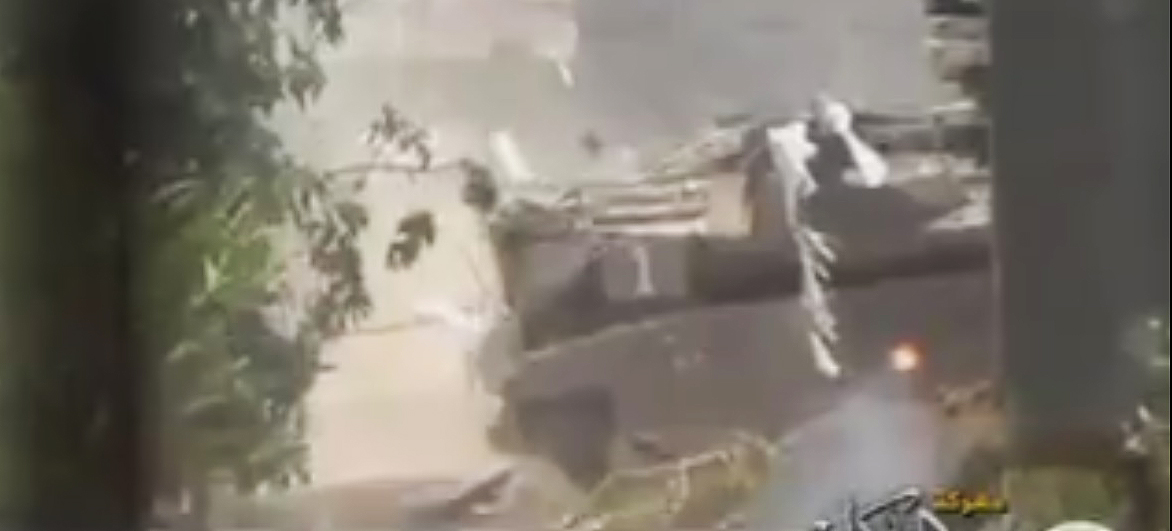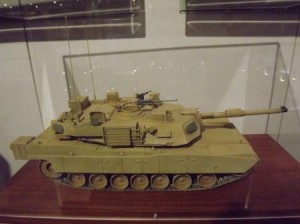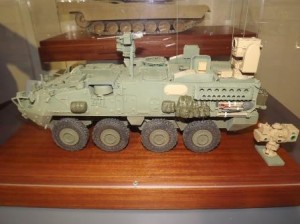
I read in FoxtrotAlpha.jalopnik.com an essay on Israel’s first combat employment of the Trophy active protection system (APS). This immediately caught my eye because of my experience modeling the system in 2003. The system is mounted on Israeli Merkava 4 tanks and Namer infantry carriers. It consists of fixed array radar to pick up incoming missiles like RPG’s and heavier anti-tank missiles. The system computes the path, aims a launcher and fires a canister filled with explosively formed projectiles (EFP). The canister explodes in close proximity to the missile where the EFP’s destroy or damage it defeating its ability to penetrate the target’s armor.
Here’s a video of a Merkava tank defeating an RPG-29 with the Trophy system in Gaza. At first Hamas thought the RPG successfully hit the tank but you can see the RPG destroyed in close proximity to the tank’s flank.
Globes reports five different Israeli armored vehicles have successfully been defended by Trophy also known as Wind Jacket in Israel. The system is manufactured by Rafael. The system can be used while on the move and against multiple threats from different directions as long as the system has ammunition. It was first fielded on Israel’s best tank the Merkava IV in 2009.
The above video depicts the Trophy Lite system for smaller vehicles like the HMMWV. Of special note, is the slow motion clip of a Trophy canister defeating an RPG round in midflight.
A final bonus of the Trophy (and other APS) is the system identifies the shooter’s location allowing the tank to slew its weapons quickly and engage the enemy before they can fire a second round. Many of top armored fighting vehicles in the world including the Merkava IV, Leopard II, M1A2 and M2A3 Bradley have independent commander’s sights. This allows the commander to find follow up targets and at the press of a switch slew the vehicles weapons on an immediate or follow up threat. Automating this capability with APS would allow for even quicker engagement of missile firing threats.
One of the major concerns about APS systems like trophy is their potential to cause injury to dismounted personnel. Rafael says troops can operate relatively safely near vehicles because the system engages incoming threats 10-30 meters from the vehicle. I’m skeptical. Being near the launchers when they fire a canister has to have some blast impact on nearby personnel and troops especially supporting Infantry are not supposed to be near the vehicle especially if they are protecting it or engaging the enemy. They, along with civilians must be at risk during the interception of an incoming round.
Trophy has come a long way since 2003 where it was a one shot system and relied on ball bearings. At that time the US was pursuing its own system in conjunction with the ill fated Future Combat System (FCS). Raytheon’s Quick Kill program provides the same capability but from a central launcher that holds 8-15 rounds.
Here’s a video of the Quick Kill system engaging a target.
The Quick Kill and Trophy systems are undergoing testing by the US Army. There is a controversy surrounding the systems with some saying the Army should have adopted Trophy and fielded it because it had a quicker development record. The argument often fails to mention even the Israelis didn’t field the system until 2009 while it was still much more dangerous to dismounted troops and civilians and still can pose a threat to those individuals in many cases. Other issues with APS systems are weight, power requirements, impact on communications, battle control systems and anti-IED systems.
APS is a promising and very welcome development in increasing vehicle survivability but it has its drawbacks that seem to be glossed over in defense media stories. In my last position before retiring, part of my duties involved supervising qualitative simulations on FCS in various future scenarios and incorporating APS to determine its potential effectiveness. This is part of the way the Army determines what technology to pursue and how much of it is wanted. We try to answer questions like, in what situations does APS have to be nonlethal to dismounted troops? How many reloads are optimal? As with any advance in survivability the reaction is an effort to overcome that advancement. Volley and multiple engagements on an APS vehicle can overwhelm the system especially if it has limited reloads and/or a limited aspect of protection. E.G. if a system needs two launchers to provide 360 degree protection an enemy can focus its attacks from on direction and eventually exhaust a system’s reloads. A material solution is a weapon that fires multiple slightly staggered rounds. The Russians have developed exactly such a system in the RPG-30.
Active Protection Systems are the future and promise to increase survivability and even drive a move to lower the weight of some armored vehicles. Israel is pursuing a system eerily similar in many ways to the failed FCS system called Future Manned Combat Vehicle (FMCV). The plan is to use APS to lower the weight of armored vehicles and use common components and have a modular capability for a variety of specific roles especially in urban environments. In that regard the FMCV is less ambitious than our FCS program.
Further Information
Various Trophy System Video


